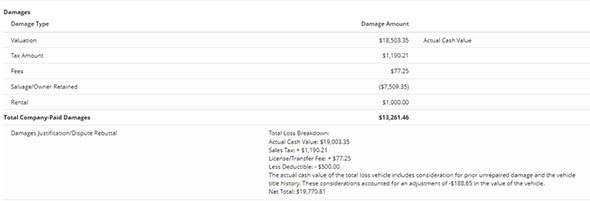 The May 2019 TRS E-Bulletin provided examples on how the recovering party should itemize its damages in TRS, and the December 2019 E-Bulletin for Arbitrators shared examples of damage disputes and guidance on applying Rule 2-5. This article will add further clarification as we continue to see issues with the itemization of damages and damage disputes in auto claims, especially concerning total loss claims.
The May 2019 TRS E-Bulletin provided examples on how the recovering party should itemize its damages in TRS, and the December 2019 E-Bulletin for Arbitrators shared examples of damage disputes and guidance on applying Rule 2-5. This article will add further clarification as we continue to see issues with the itemization of damages and damage disputes in auto claims, especially concerning total loss claims.Rule 2-1 does not have any requirement as to how damages are to be itemized. Rather, our TRS application includes templates to use when the damages sought pertain to a vehicle that has either been repaired or rendered a total loss. The template is intended to capture the different damages included in the filing and the specific damages in dispute.
The issue with total loss claims is the varying manner in how companies categorize the damages, specifically those included under salvage. Some companies include towing and/or storage charges that are included on the salvage invoice. Others itemize these damages separately. While itemizing the damages may be the preferred approach to allow a Responding company to dispute specific damages, either way is acceptable.
In the example below, the filing company included $7,509.35 for salvage/owner-retained damages, which includes storage damages totaling $1,650 (22 days at $75). The responding company disputed this amount, arguing that only $750 is owed (10 days at $75).
While the storage damages were not itemized on their own, the responding company was able to identify and dispute the specific damages. How the damages were itemized was not an issue. The arbitrator must consider and rule on the damage dispute.


The above is just one example specific to the salvage category. The key point to remember as an arbitrator is to resolve the member’s dispute. If, for example, a tow charge is incorrectly itemized as storage, but the responding company is able to dispute the amount sought, render a decision on the damage dispute. The arbitrator should not disregard the dispute because the incorrect damage type was selected. Another example is where the condition adjustment is included with the valuation. Award the damages if supported and not disputed, even if you believe the expense should have been entered under “Add to Valuation.”
In closing, this article is intended for general educational purposes. It does not address every scenario that might arise, and is not to be used as evidence to support a party’s position on dispute damages.



